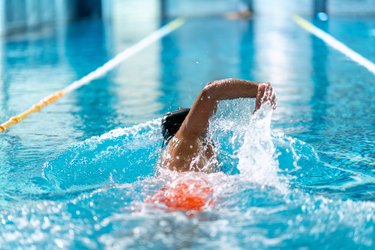
When it comes to low-impact cardio workouts, it doesn't get much better than swimming.
After all, swimming workouts pack all of the benefits of cardiovascular exercise — a stronger heart, fitter muscles and torched calories — without all of the shock that can come with high-impact workouts.
Video of the Day
Video of the Day
"For people with arthritis, osteoporosis or certain autoimmune conditions, swimming is one of the best ways to exercise," says certified swimming instructor Erin Trumbach. These conditions can make people's bones and joints susceptible to injury during higher-impact activities like running, she says.
In the pool, however, water supports the body's weight to eliminate the force of gravity on the bones and joints. Without the impact, or force of the body "pounding the pavement," people with sensitive joints are able to get in a great workout without potential land-based discomfort, Trumbach says.
Bonus: According to the Centers for Disease Control and Prevention (CDC), many people enjoy water-based exercise more than other forms of exercise, which may encourage them to exercise for longer and more frequently. And we all know that the best cardio workout is the one you will stick with.
If you have access to a pool, jump in for some low-impact cardio. This swimming routine is sure to give your heart, lungs and muscles the workout they deserve.
How to Do This Low-Impact Swimming Workout
This session comes in three parts: a warm-up, intervals and a cooldown. The whole thing will take around 30 minutes if you can swim 50 meters in about 2 minutes, a realistic timeline for many beginners, according to Trumbach. (A standard lap is 25 meters, or the length of an Olympic-sized pool.)
Faster? Slower? That's OK! If you can swim 50 meters in 90 seconds or less, try upping your interval distances by 25 meters each. If your 50-meter swims take longer than 2 minutes and 30 seconds, you may want to allocate 45 minutes for this workout or cut the 50-meter swims down to 25-meter swims to save yourself some time, she says.
You'll need a kickboard, and you may also want to wear goggles to protect your eyes. A swim cap and a tight-fitting swimsuit can reduce drag in the water.
Need a Refresher on Your Strokes?
Experts break down the five most common swimming strokes here.
The Warm-Up
Gradually raise your heart rate and warm up your muscles by alternating between 50-yard freestyle swims and flutter kicks on a kickboard.
Do:
- 50-yard freestyle (easy pace)
- 50-yard flutter kick (with a kickboard; easy pace)
- 50-yard freestyle (easy pace)
- 50-yard flutter kick (with a kickboard; easy pace)
The Intervals
Alternate between freestyle, backstroke and breaststroke or choose the stroke you find most comfortable. You'll do four 50-meter swims at a moderate pace followed by four 25-meter swims at an intense pace. Rest for 30 seconds between intervals.
Do:
- 50-meter swim (moderate pace)
- 30-second rest
- 50-meter swim (moderate pace)
- 30-second rest
- 50-meter swim (moderate pace)
- 30-second rest
- 50-meter swim (moderate pace)
- 30-second rest
- 25-meter swim (intense pace)
- 30-second rest
- 25-meter swim (intense pace)
- 30-second rest
- 25-meter swim (intense pace)
- 30-second rest
- 25-meter swim (intense pace)
- 30-second rest
The Cooldown
When you finish all of your intervals in the main set, help your body recover by completing a gentle 100-meter freestyle cooldown.
Do:
- 100-meter swim (easy pace)
A Note on Swimming Safety
While swimming is fun and makes for an excellent workout, Trumbach encourages people to remember that it comes with risks and deserves respect. "Don't overdo it or push yourself too hard," she says. "You really have to know your limits in the pool."
People often underestimate the physical capacity swimming workouts require, she says, which can lead to poor technique, excessive fatigue and potentially dangerous accidents.
Ditch the "it won't happen to me" mindset and pay close attention to your body while swimming. While your heart rate and breathing should increase while exercising, you should feel like you have complete control over your body. If you start to feel overly fatigued, dizzy or weak, take a break or stop.
"Bring a buddy if you can, breathe more often than you think you need to or even stick to the kickboard if you're not comfortable with full-out swimming yet."
Related Reading
Was this article helpful?
150 Characters Max
0/150
Thank you for sharing!
Thank you for your feedback!